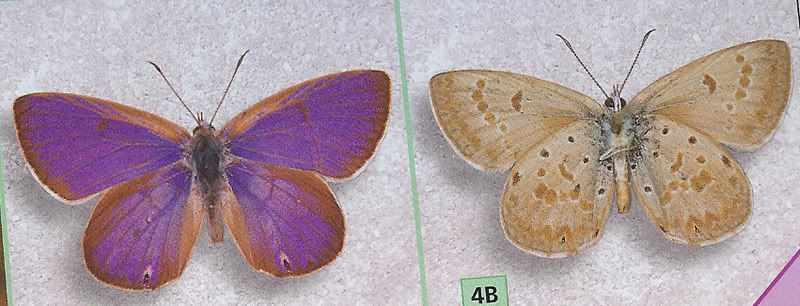|
|
Post by Melanie on Jul 9, 2005 0:00:59 GMT
Morant's Blue
(Lepidochrysops hypopolia)
The rarest of the Lepidochrysops, and categorised as extinct in the South African Red Data Book- Butterflies (S.F. & G.A. Henning 1989), is Lepidochrysops hypopolia (Trimen and Bowker, 1887). The common name is Morant’s blue. It is only known from 2 males taken by Walter Morant on 21 September, 1870 at Blue Bank, near Ladysmith (KwaZulu-Natal), and a single male caught by Thomas Ayres near Potchefstroom (North West Province) in 1879. The Morant specimens are in the Natural History Museum, London and the Ayres specimen is in the South African Museum, Cape Town.
|
|
|
|
Post by another specialist on Aug 8, 2005 4:40:16 GMT
|
|
|
|
Post by sebbe67 on Dec 10, 2006 20:01:42 GMT
Work on Lepidochrysops Hypoplia has been going on for three years. Between the dates of : July-August 2004 in three localities August-September 2005 in the same localities September-October 2006 in the same localities. Maybe in October-November 2007 we will be lucky to find it. Earle Whiteley, Conservation of Butterflies in South Africa www.sabutterflies.co.za |
|
|
|
Post by sebbe67 on Jan 8, 2007 19:32:39 GMT
 Source: A field guide to the butterflies of South Africa |
|
Deleted
Deleted Member
Posts: 0
|
Post by Deleted on Jan 19, 2007 13:27:13 GMT
Hi !
What a beautiful butterfly !
Is the wingspan mentioned in that book ?
|
|
|
|
Post by sebbe67 on Jan 19, 2007 13:51:30 GMT
Hi ! What a beautiful butterfly ! Is the wingspan mentioned in that book ? Nope, nothing mentioned about size |
|
|
|
Post by Bowhead Whale on Jan 23, 2007 20:30:30 GMT
Beautiful indeed. But I think there are other butterflies still existing that look a lot like this one. Am I right?
|
|
|
|
Post by sebbe67 on Jan 23, 2007 21:26:17 GMT
Beautiful indeed. But I think there are other butterflies still existing that look a lot like this one. Am I right? At least species looking very similar. |
|
|
|
Post by Bowhead Whale on Jan 25, 2007 19:05:17 GMT
I knew it. Lepidochrysops is a relatively common genre, to my (relative) knowledge.
|
|
|
|
Post by surroundx on May 5, 2012 8:46:03 GMT
" Lepidochrysops hypopolia (Trimen & Bowker, 1887) Type locality [SA: KZN, NW]—‘Natal. Upper Districts. - Blue Bank, near Drakensberg; Transvaal - Potchefstroom District’. Common name Morant’s Blue, Morant-bloutjie (A). Status Extinct [EX]. Distribution SA: KZN—Blue Bank, near Ladysmith; NW—Potchefstroom. ECOLOGYRange & population Blue Bank, near Ladysmith in KwaZulu-Natal (two males caught by Walter Morant on 21 September 1870), and near Potchefstroom (North West Province) (one male leg. Thomas Ayres in 1879). Habitat Possibly KwaZulu-Natal Highland Thornveld (Sub-Escarpment Grassland Bioregion) and Carletonville Dolomite Grassland (Dry Highveld Grassland Bioregion) in the Grassland Biome Unit (Mucina et al. 2005). The exact localities are unknown. The identity of a single putative female, collected by C.W. Morrison near Estcourt (KwaZulu-Natal), is unconfirmed. The Morant specimens are in The Natural History Museum (BMNH), London, and the Ayres specimen is in the South African Museum (SAM), Cape Town. RATIONALENo verified specimens have been seen since 1879. There are only three known specimens of this taxon. The undersurfaces of the specimens are lighter (more ‘hoary’) than the closely related (probable sister species) Lepidochrysops praeterita Swanepoel. There was some speculation that the three known specimens were possibly chemically bleached examples of L. praeterita (G.A. Henning, pers. comm. 2004). If this is the case, then the two taxa are conspecific. However, the upper surfaces are not bleached and the outer margins of the forewings of the male specimens are more convex than in L. praeterita. This taxon was listed as Extinct in S.F. Henning & G.A. Henning (1989) and G.A. Henning & S.F. Henning (1992b). THREATSNo locality is known and therefore no threats can be identified. CONSERVATIONTechnically (IUCN categories) the species is regarded as Extinct." www.sanbi.org/sites/default/files/documents/documents/biodiversity13butterflies.pdf (pp. 54-55) |
|
|
|
Post by surroundx on May 5, 2012 8:48:37 GMT
Photographs of preserved specimens can be seen on pp. 124 of the paper linked to in the post immediately above this one.
|
|
|
|
Post by Melanie on May 5, 2012 14:43:07 GMT
|
|
|
|
Post by Melanie on May 7, 2012 10:17:03 GMT
|
|
|
|
Post by koeiyabe on Jan 31, 2016 1:10:49 GMT
"Extinct Entomological Data File (in Japanese)" by Toshio Inmate (2002)  |
|
|
|
Post by surroundx on Mar 26, 2016 9:36:00 GMT
|
|